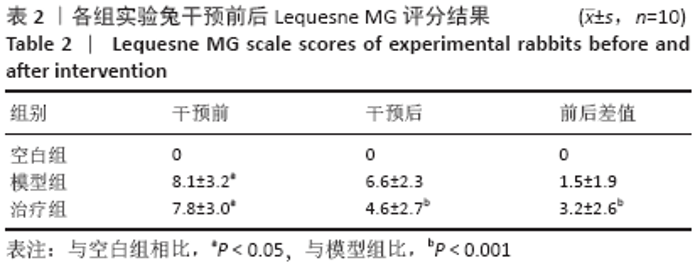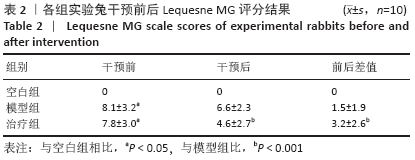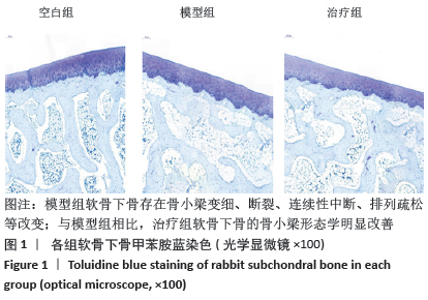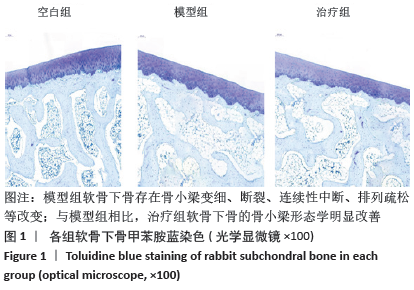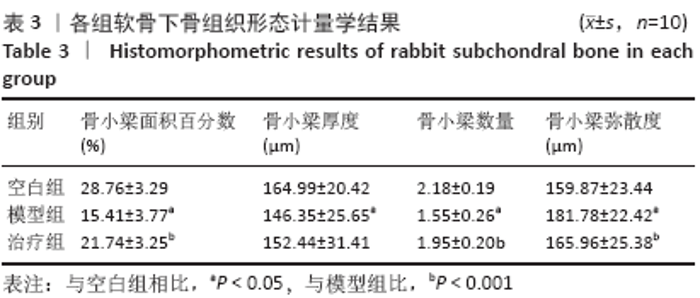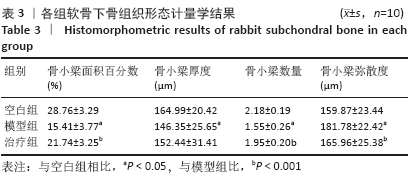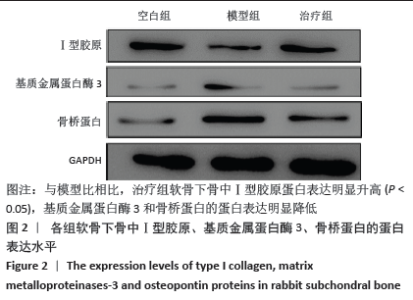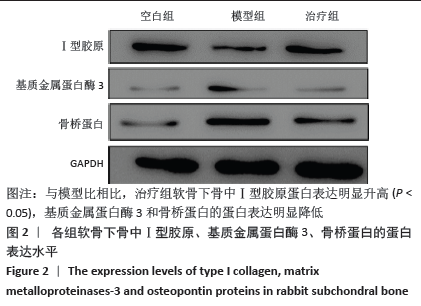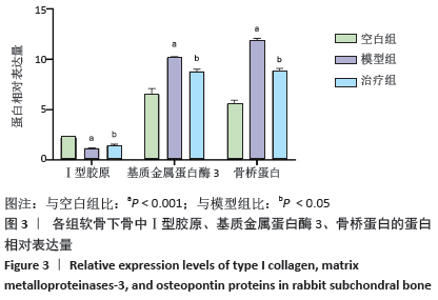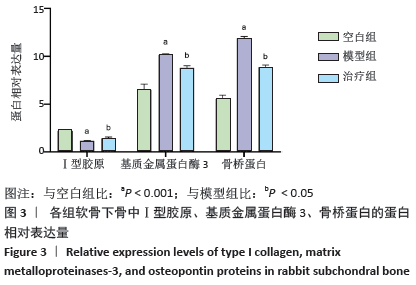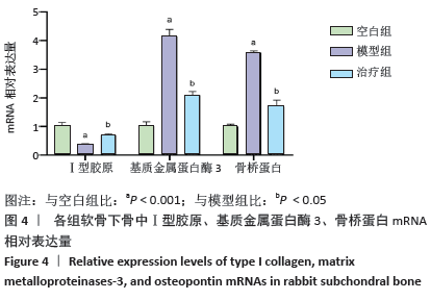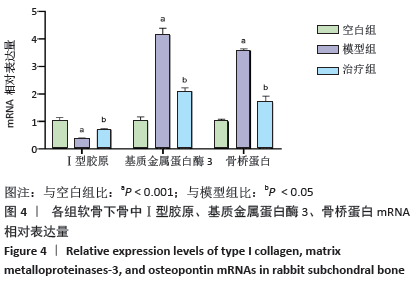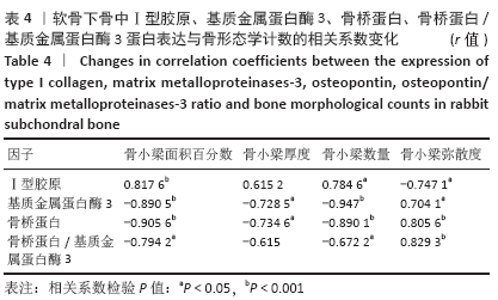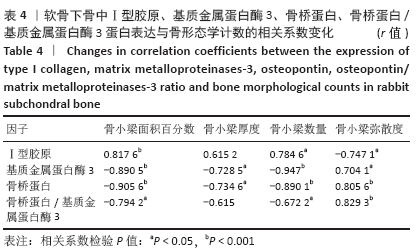[1] HUNTER DJ, BIERMA-ZEINSTRA S. Osteoarthritis. Lancet. 2019;393 (10182):1745-1759.
[2] SCHULZE-TANZIL G. Intraarticular Ligament Degeneration Is Interrelated with Cartilage and Bone Destruction in Osteoarthritis. Cells. 2019;8(9):990.
[3] HL S, CE K. The Importance of Subchondral Bone in the Pathophysiology of Osteoarthritis. Front Vet Sci. 2018;5:178.
[4] CASTA EDA S, ROMAN-BLAS JA, LARGO R, et al. Subchondral bone as a key target for osteoarthritis treatment. Biochem Pharmacol. 2012; 83(3):315-323.
[5] DONELL S.Subchondral bone remodelling in osteoarthritis.EFORT Open Rev. 2019;4(6):221-229.
[6] LAHM A, DABRAVOLSKI D, RÖDIG J, et al. Varying development of femoral and tibial subchondral bone tissue and their interaction with articular cartilage during progressing osteoarthritis.Arch Orthop Trauma Surg. 2020 May 30.doi: 10.1007/s00402-020-03480-w.
[7] 张晨,马骏,吕雷锋,等.盐酸氨基葡萄糖对膝骨关节炎膝关节软骨下骨Ⅰ型胶原及骨钙素表达的影响[J].郑州大学学报(医学版), 2017,52(1):9-13.
[8] ZENG JJ, WANG HD, SHEN ZW, et al. Curcumin Inhibits Proliferation of Synovial Cells by Downregulating Expression of Matrix Metalloproteinase-3 in Osteoarthritis.Orthop Surg. 2019;11(1):117-125.
[9] WANG Y, QIU Y, LI J,et al. Low-intensity pulsed ultrasound promotes alveolar bone regeneration in a periodontal injury model.Ultrasonics. 2018;90:166-172.
[10] YAMAMOTO K, WILKINSON D, BOU-GHARIOS G. Targeting Dysregulation of Metalloproteinase Activity in Osteoarthritis. Calcif Tissue Int. 2020 Aug 9. doi: 10.1007/s00223-020-00739-7.
[11] 寿崟,刘苗苗,周俊梅,等.电针对膝骨关节炎MIA模型大鼠软骨组织中Ⅰ型胶原蛋白基因表达的影响[J]. 上海针灸杂志, 2016, 35(9):1119-1121.
[12] 岳萍, 高亮, 陈默, 等. 温针灸对膝骨性关节炎兔行为学及关节软骨肿瘤坏死因子-α、基质金属蛋白酶-3含量的影响[J]. 针刺研究, 2016,41(3):235-239.
[13] 张德清, 张雪斐, 张灵鹏, 等. 温针灸联合独活寄生汤治疗膝骨性关节炎疗效及对关节滑液中骨桥蛋白和血管内皮生长因子水平影响[J]. 中国卫生检验杂志,2017,27(19):2754-2756,2760.
[14] 张琳, 高谦. 内热针疗法的作用机制及临床研究进展[J]. 首都食品与医药,2016(24):21-23.
[15] 吴强, 郑倩华, 蒋一璐, 等. 膝骨性关节炎动物模型选择与制备的比较[J]. 中国比较医学杂志,2019,29(5):125-130.
[16] Yang YH, Liu TH, Zhang LD, et al. Role of the PERK-eIF2α-CHOP Signaling Pathway in the Effect of Needle Knife Therapy on Knee Joint Chondrocyte Apoptosis.Evid Based Complement Alternat Med. 2019;2019:7164916.
[17] YE W, GUO H, YANG X, et al. Pulsed Electromagnetic Field Versus Whole Body Vibration on Cartilage and Subchondral Trabecular Bone in Mice With Knee Osteoarthritis. Bioelectromagnetics. 2020;41(4):298-307.
[18] YANG Y, LI P, ZHU S, et al. Comparison of early-stage changes of osteoarthritis in cartilage and subchondral bone between two different rat models. PeerJ. 2020;8:e8934.
[19] HE Z, CHU L, LIU X, et al. Differences in subchondral trabecular bone microstructure and finite element analysis-based biomechanical properties between osteoporosis and osteoarthritis. J Orthop Translat. 2020;24:39-45.
[20] 刘巧媚, 徐芸, 尹晶, 等.内热针治疗髌下脂肪垫损伤临床疗效观察[C].中国针灸学会专题学术会议暨夹脊穴的理论研究与临床应用学术研讨会, 2013.
[21] 高谦,王飞,杨志丽,等.银质针与软组织内热治疗仪对大鼠骨骼肌作用的实验研究[J].临床军医杂志,2009,37(5):758-760.
[22] 王刚,高谦,杨志丽,等.不同针刺法对大鼠腓肠肌砸伤后微循环血流灌注的影响[J].军医进修学院学报,2011,32(6):651-653.
[23] 杨志丽,高谦,王刚,等.软组织内热针与银质针对大鼠骨骼肌慢性损伤后SOD、MDA水平的影响[J].中华保健医学杂志,2011, 13(1):28-30.
[24] 张文玉, 高谦, 王刚, 等. 软组织内热针对大鼠慢性损伤后血管内皮生长因子及内源性碱性成纤维细胞生长因子的影响[J].中华保健医学杂志,2012,14(3):193-196.
[25] 刘洁明, 胡冬梅, 郭子斌, 等. 内热针临床应用研究概述[J]. 中国民族民间医药,2017,26(7):49-51.
[26] 万超,朱小虎,程宇核,等.内热针疗法对膝骨关节炎大鼠软骨细胞凋亡及Caspase-3和Caspase-9表达的影响[J]. 中国针灸,2019, 39(4):409-416.
[27] YIĞITER Ö, YORUKOGLU A C, ŞENTÜRK N, et al. The effects of type I collagen on bone defects and gene expression changes for osteogenesis: In a rat model. J Cell Biochem. 2019 Feb 28.doi: 10.1002/jcb.28432.
[28] BOU-GHARIOS G, ABRAHAM D, CROMBRUGGHE BD. Type I collagen structure, synthesis, and regulation. Principles of Bone Biology. 2020: 295-337.
[29] 陈益丹, 邱华平, 金肖青, 等.不同针灸方法对膝骨关节炎模型细胞因子及基质金属蛋白酶影响的比较研究[J]. 中国比较医学杂志, 2016,26(1):42-45.
[30] 周艳, 罗凛. 温经通络汤联合针灸治疗风寒湿痹型类风湿关节炎疗效及对血清Wnt-3α、β-catenin、BMP-2的影响[J]. 现代中西医结合杂志,2019,28(30):3375-3378.
[31] 武永利, 刘娣, 马晓秀, 等. 温针灸对兔膝骨性关节炎模型软骨细胞中c-Jun氨基末端激酶信号通路的影响[J]. 中国中西医结合杂志, 2017,37(11):1372-1377.
[32] CHOW YY, CHIN KY. The Role of Inflammation in the Pathogenesis of Osteoarthritis.Mediators Inflamm. 2020;2020:8293921.
[33] SHIBAKAWA A, YUDOH K, MASUKO-HONGO K, et al. The role of subchondral bone resorption pits in osteoarthritis: MMP production by cells derived from bone marrow. Osteoarthritis Cartilage. 2005; 13(8):679-687.
[34] Min S, Shi T, Han X, et al. Serum levels of leptin, osteopontin, and sclerostin in patients with and without knee osteoarthritis. Clin Rheumatol. 2020 Jun 25. doi: 10.1007/s10067-020-05150-z.
[35] SI J, WANG C, ZHANG DH, et al. Osteopontin in Bone Metabolism and Bone Diseases. Med Sci Monit. 2020;26:e919159.
[36] 张汉庆, 戴燚, 李浩, 等. 绝经后妇女骨代谢过程中血清基质金属蛋白酶3和骨桥蛋白的变化[J].中国组织工程研究与临床康复, 2011,15(41):7783-7786.
[37] 林如意, 孙定炯, 叶锐, 等. 温针灸治疗膝关节骨关节炎的效果及对OPG、MMP-3水平的影响[J]. 中华中医药学刊,2019,37(6): 1485-1487.
[38] 雷杰锋, 雷光华.人膝骨关节炎软骨下骨OPN的表达及其意义[J]. 现代生物医学进展,2011,11(22):4269-4272.
[39] 张荣凯,方航,卢华定, 等. MMP3在早期骨关节炎模型软骨下骨的表达及其意义[J]. 中国病理生理杂志,2011,27(12):2391-2395.
|
